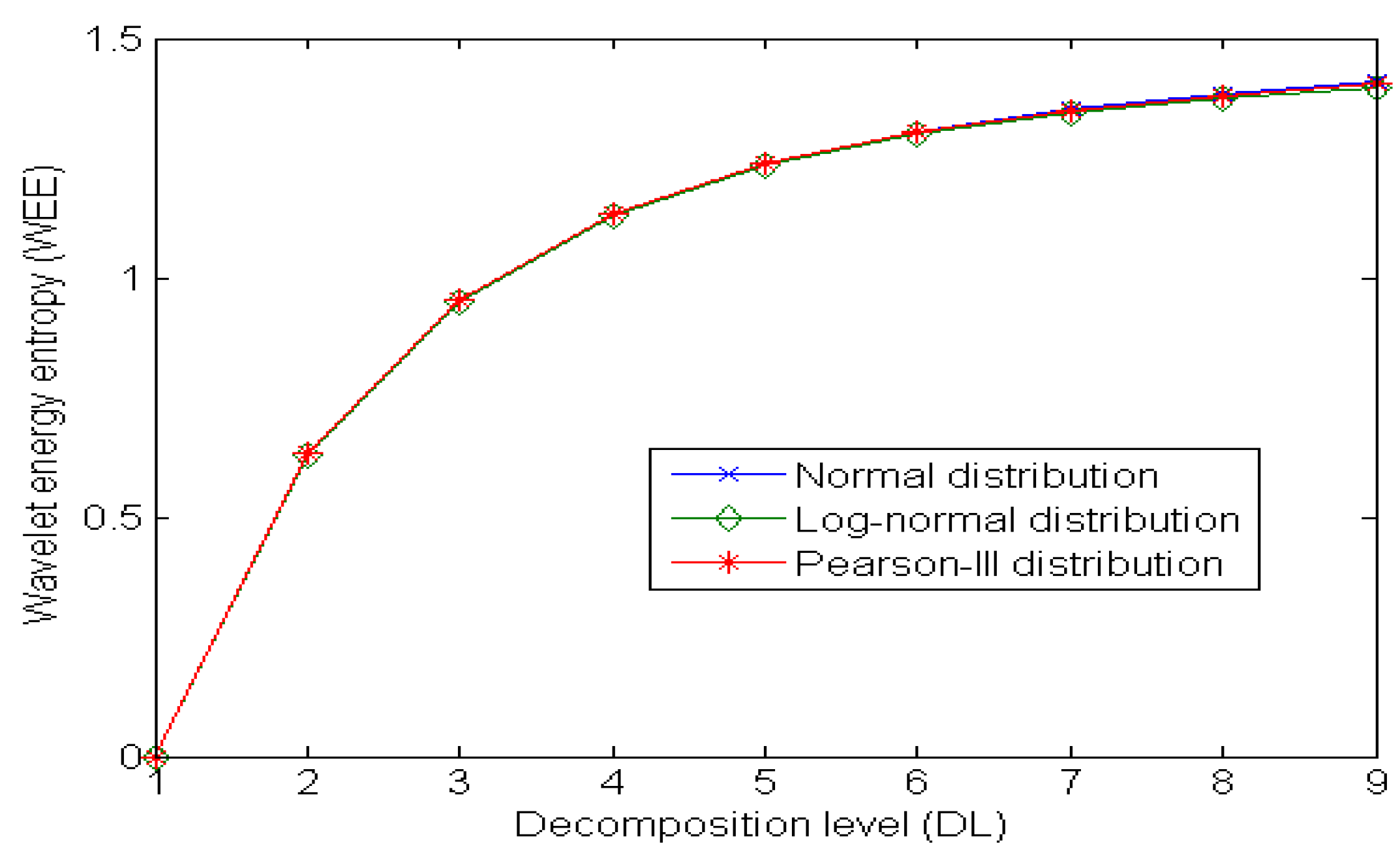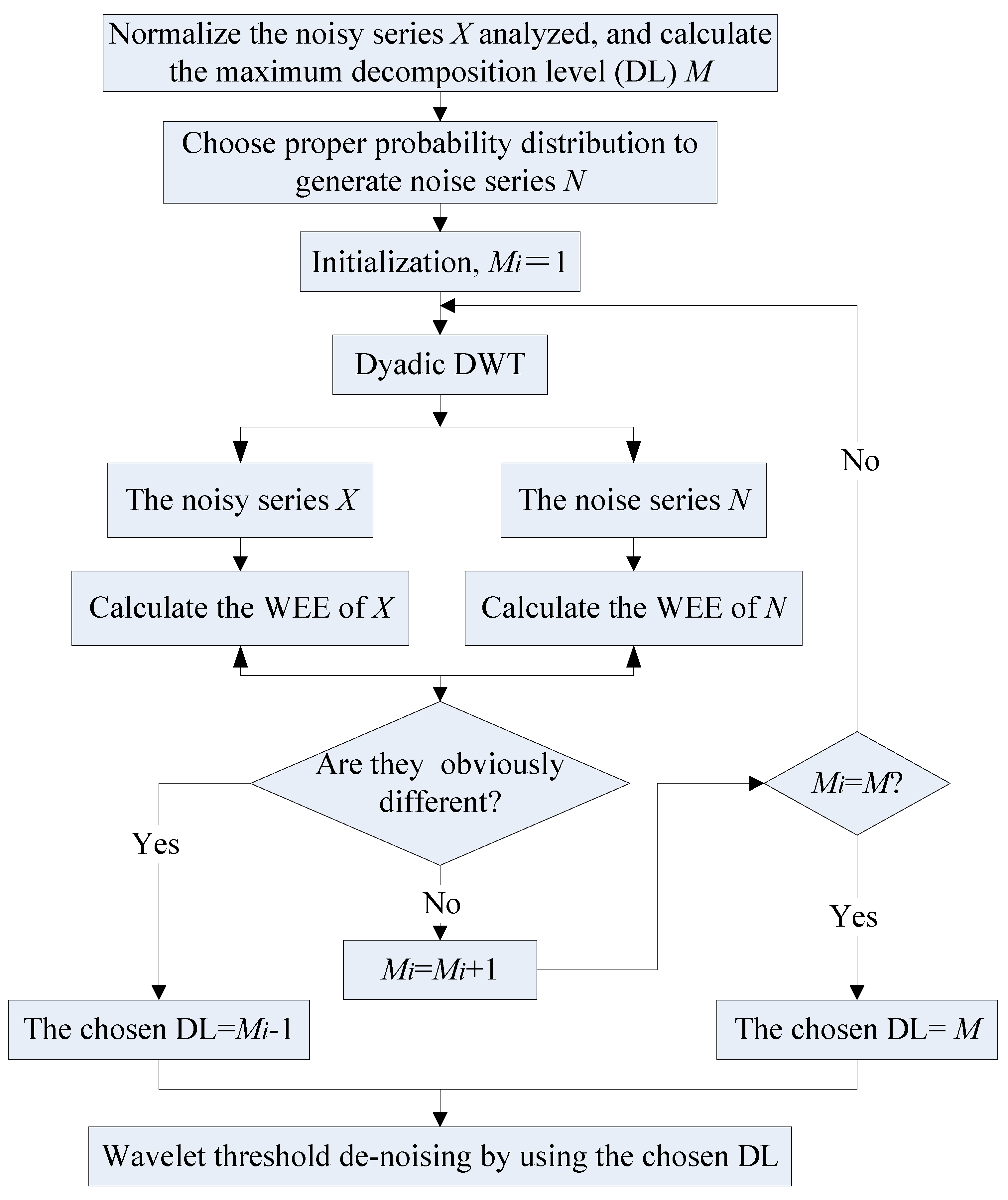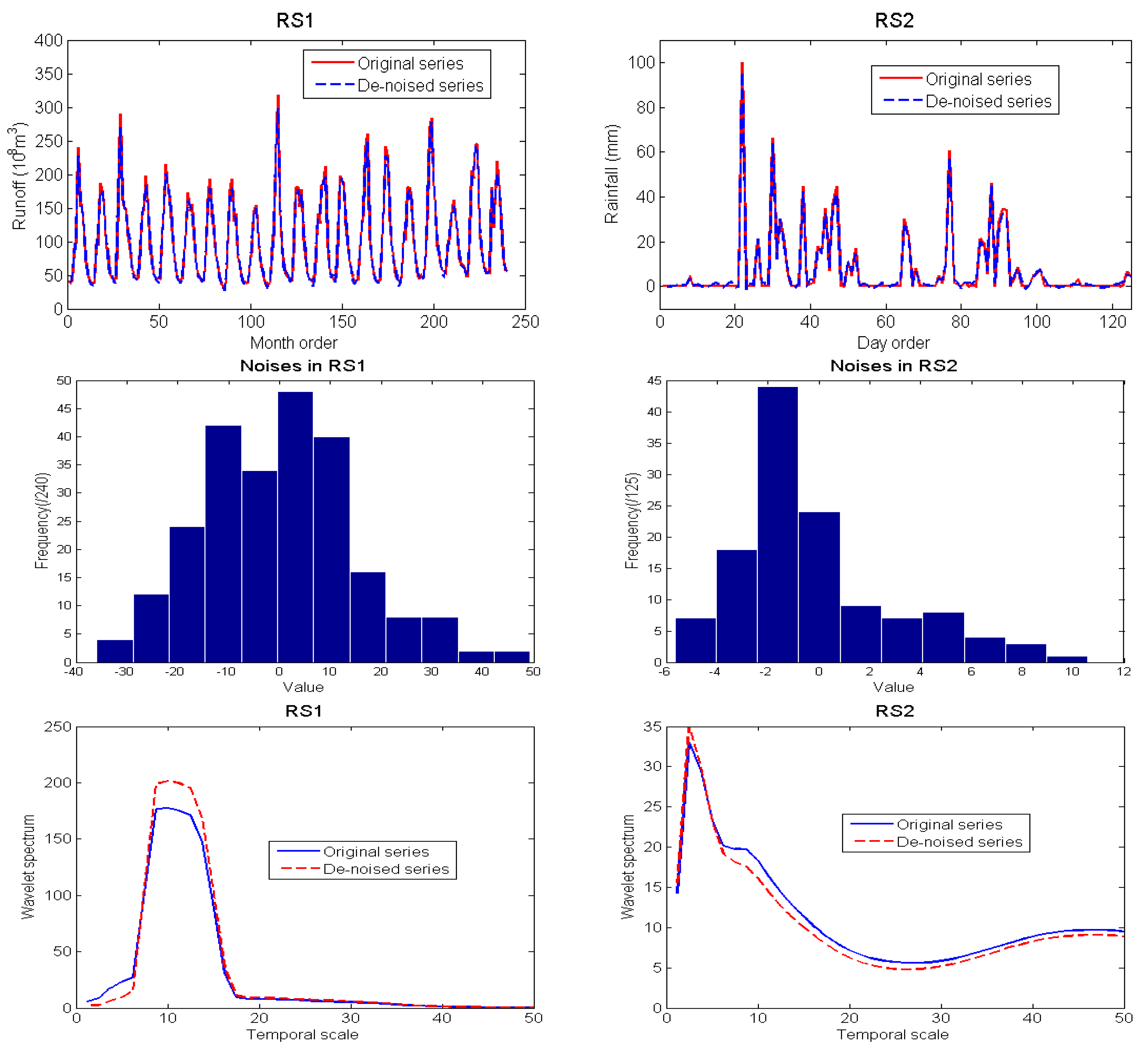Both synthetic series and observed series data are analyzed here to verify the performance of the proposed method. All of them are also analyzed by the white noise testing method for comparison. Other wavelet-based de-noising methods are not included here, considering that they have been discussed and compared with the entropy-based WTD method in [
13]. Moreover, three quantitative indexes, SNR (signal-to-noise ratio), MSE (mean square error) and R
xy (lag-0 cross-correlation coefficient) in Equation (7), are used to judge the accuracy of de-noising results obtained by using different DLs, mainly to ensure the soundness of conclusions. Besides, the wavelet variance estimator is also used to compare these different de-noising results [
23]. Because the energy distributions of various noises are just the same, the normally distributed noise is used here;
in which
and
is the mean of real series
S and the de-noised series
S~ respectively, and
N is the separated noise.
Var() means calculating the variance.
3.1. Synthetic Series Analysis
Three synthetic series are generated by the Monte-Carlo method and are shown in
Figure 4.
Figure 4.
Three synthetic series data used in this paper.
Figure 4.
Three synthetic series data used in this paper.
Among them, the SS1 series has first an upward and then a downward trend, the SS2 series has two periods of 100 and 500; whereas the SS3 series has a damped period. Their real values of SNR are −9.562, −4.012 and −3.365 respectively. Considering that the noise-contaminated degrees of them are serious, we deem that the proposed method is effective provided that it is suitable for the three synthetic series.
Each of the three synthetic series is analyzed by the proposed method using the “coif5” wavelet. The calculated WEE curves of them are depicted in
Figure 5. Furthermore, they are de-noised by the WTD method in [
13] using different DLs. The calculation results of SNR, MSE and R
xy are summarized in
Table 3, and the wavelet variance curves of these de-noised series obtained by using different DLs are presented in
Figure 6.
Figure 5.
Values of WEE of three synthetic series and the corresponding derivation coefficients when analyzed by using different decomposition levels (DLs).
Figure 5.
Values of WEE of three synthetic series and the corresponding derivation coefficients when analyzed by using different decomposition levels (DLs).
Table 3.
De-noising results of three synthetic series by using different decomposition levels (DLs).
Table 3.
De-noising results of three synthetic series by using different decomposition levels (DLs).
| Series | Index | Real value | Decomposition level (DL) |
|---|
| 1 | 2 | 3 | 4 | 5 | 6 | 7 | 8 | 9 |
|---|
| SS1 | SNR | -9.562 | 4.844 | -2.121 | -5.543 | -7.466 | -8.310 | -9.383 | -9.581 | -9.530 | -9.545 |
| MSE | | 0.469 | 0.236 | 0.121 | 0.065 | 0.040 | 0.013 | 0.005 | 0.004 | 0.010 |
| Rxy | | 0.665 | 0.782 | 0.870 | 0.922 | 0.949 | 0.983 | 0.993 | 0.995 | 0.987 |
| SS2 | SNR | -4.012 | 7.054 | 0.954 | -1.833 | -3.983 | -18.58 | -19.18 | -19.67 | -25.38 | -29.27 |
| MSE | | 1.708 | 0.839 | 0.417 | 0.387 | 1.500 | 1.481 | 1.458 | 1.59 | 1.611 |
| Rxy | | 0.760 | 0.858 | 0.921 | 0.921 | 0.640 | 0.650 | 0.661 | 0.660 | 0.706 |
| SS3 | SNR | -3.365 | 7.867 | 1.811 | -1.048 | -1.792 | -4.525 | -10.46 | -17.82 | -19.45 | -19.53 |
| MSE | | 0.305 | 0.146 | 0.067 | 0.046 | 0.074 | 0.158 | 0.191 | 0.211 | 0.224 |
| Rxy | | 0.775 | 0.871 | 0.934 | 0.953 | 0.918 | 0.817 | 0.817 | 0.794 | 0.768 |
Figure 6.
Wavelet variance curves of the de-noised synthetic series obtained by using different decomposition levels (DLs).
Figure 6.
Wavelet variance curves of the de-noised synthetic series obtained by using different decomposition levels (DLs).
The analytic results in
Figure 5 indicate that the chosen DLs are different for the three synthetic series with different real signals. Concretely, the WEEs of SS1 series are very close to those of noise under the DLs from 1 to 8, whereas the sub-signal under the DL 9 is part of the trend of SS1 series, so its WEE has big difference with that of noise. The WEEs of SS2 series and noise are very similar under the DLs from 1 to 4; but they show obvious differences under the DL 5 and the value of
D(5) is an extreme value, because the sub-signal of SS2 series under the DL 5 corresponds to the period of 200. As for SS3 series, its WEEs are close to those of noise before the DL 4, but they are obviously different under the DL 5 and the value of
D(5) is also an extreme value. Furthermore, analytic results in
Table 3 show that de-noising results of these synthetic series vary with the DL used. To be specific, the de-noising result of SS1 series by using the DL 8 is the best, because the MSE with the value of 0.004 is the smallest, the R
xy with the value of 0.995 is the biggest, and the calculated SNR of −9.530 is very close to the real SNR of −9.562. For SS2 series, the values of SNR, MSE and R
xy under the DL 4 are −3.983, 0.387 and 0.921 respectively, all of which are the best results among those under different DLs; and for SS3 series, the SNR, MSE and R
xy of −1.792, 0.046 and 0.953 under the DL 4 are also the best results among those under different DLs. Besides,
Figure 6 on one hand shows the same conclusions as those in
Table 3; on the other hand, it shows that the wavelet variance curves of de-noised series reflect irregular fluctuations under small temporal scales when using the smaller DLs, which means that noise is not removed completely; whereas the de-noised series’ wavelet spectral densities under small scales are smaller than the real values when using the bigger DLs, which means that several real signals are removed. As a result, all the results in
Figure 5,
Figure 6 and
Table 3 show the same conclusion: the chosen DLs for the three synthetics series are 8, 4 and 4 respectively. Finally, these synthetic series are de-noised by using the chosen DLs, and the results are presented in
Figure 7.
Figure 7.
De-noising results of the three synthetic series by using the chosen decomposition levels (DLs).
Figure 7.
De-noising results of the three synthetic series by using the chosen decomposition levels (DLs).
In addition, the lag-1 autocorrelation coefficient
R1 of the sub-signals of these synthetic series under different levels is calculated, and the results are listed in
Table 4. It indicates that no matter which synthetic series is analyzed, their sub-signals under different DLs cannot pass the white noise testing, because the smallest absolute value of the
R1 of them is 0.326, 0.326 and 0.341, respectively under the DL 2. Therefore, it can be further concluded that analytic results by the proposed method are more reliable.
Table 4.
Calculation results of the lag-1 autocorrelation coefficient R1 of the sub-signals of synthetic series under different decomposition levels (DLs).
Table 4.
Calculation results of the lag-1 autocorrelation coefficient R1 of the sub-signals of synthetic series under different decomposition levels (DLs).
| Series | Decomposition level (DL) |
|---|
| | 1 | 2 | 3 | 4 | 5 | 6 | 7 | 8 | 9 |
|---|
| SS1 | -0.646 | 0.326 | 0.804 | 0.940 | 0.990 | 0.998 | 0.998 | 0.996 | 1.000 |
| SS2 | -0.579 | 0.326 | 0.810 | 0.949 | 0.990 | 0.996 | 0.999 | 0.999 | 0.998 |
| SS3 | -0.642 | 0.341 | 0.814 | 0.937 | 0.987 | 0.994 | 0.996 | 0.999 | 0.998 |
3.2. Observed Series Analysis
Two observed hydrologic series, RS1 and RS2, are analyzed here to further verify the performance of the proposed method. Among them, RS1 presents 20 years (1978–1997) of monthly runoff series measured at the Dashankou hydrologic station at Kaidu River in the northwest of China, and it has two obvious periods of about 6 months and 12 months [
4]. RS2 presents 125-day rainfall series (June 1 to October 3 in 2003) measured in Hanqiao Coal Mine located in the mid-eastern of China [
25].
The two series are analyzed by using the “dmey” and “db6” wavelets, respectively [
4,
25]. Their WEE curves are shown in
Figure 8. Then, they are de-noised and the results are presented in
Figure 9 and
Table 5. Besides, analytic results by the white noise testing method are listed in
Table 6.
Figure 8.
Values of WEE of the two observed series and the corresponding derivation coefficients when analyzed by using different decomposition levels (DLs).
Figure 8.
Values of WEE of the two observed series and the corresponding derivation coefficients when analyzed by using different decomposition levels (DLs).
Figure 9.
De-noising results of the two observed series by using the chosen decomposition levels (DLs) (upper), histograms of the separated noise (mid) and the wavelet variance curves of the de-noised series and observed series data (lower).
Figure 9.
De-noising results of the two observed series by using the chosen decomposition levels (DLs) (upper), histograms of the separated noise (mid) and the wavelet variance curves of the de-noised series and observed series data (lower).
Table 5.
Calculated values of SNR of the two de-noised observed series data by using different decomposition levels (DLs).
Table 5.
Calculated values of SNR of the two de-noised observed series data by using different decomposition levels (DLs).
| Series | Decomposition level (DL) |
|---|
| 1 | 2 | 3 | 4 | 5 | 6 | 7 |
|---|
| RS1 | 30.904 | 26.768 | 20.049 | 18.200 | 17.297 | 16.705 | 16.285 |
| RS2 | 30.908 | 50.205 | 48.944 | 48.707 | 48.622 | 48.550 | |
Table 6.
Calculation results of the lag-1 autocorrelation coefficient R1 of sub-signals of the two observed series under different decomposition levels (DLs).
Table 6.
Calculation results of the lag-1 autocorrelation coefficient R1 of sub-signals of the two observed series under different decomposition levels (DLs).
| Series | Decomposition level (DL) |
|---|
| 1 | 2 | 3 | 4 | 5 | 6 | 7 |
|---|
| RS1 | -0.562 | 0.431 | 0.856 | 0.962 | 0.980 | 0.995 | 0.999 |
| RS2 | -0.567 | 0.424 | 0.844 | 0.951 | 0.990 | 0.986 | |
Table 5 shows that de-noising results of the two observed series vary with the DLs used. Moreover, for the RS1 series, its sub-signals under the first two DLs are composed of noise, but the sub-signal under the DL 3 corresponds to the period of 6 months [
4]. As for the RS2 series, it mainly reflects the daily rainfall in the rainy season in 2003 thus has no obvious periods [
25], and its sub-signals under the DLs from 1 to 6 are mainly composed of noise, whereas the approximations wavelet coefficients under the DL 6 reflect the trend of RS2 series. Therefore, analytic results in
Figure 8 indicate that the
D(3) of WEE of RS1 series is an extreme value but that of RS2 series has no extreme value. As a result, the chosen DL for de-noising of RS1 and RS2 series is 2 and 6, and the calculated values of SNR is 26.768 and 48.550 respectively. Besides, the results in
Figure 9 indicate that: (1) because just a little noise is included, the original series and de-noised series are similar; (2) from the qualitative point of view, the noise separated form RS1 series follows normal distribution, whereas the noise separated from the RS2 series more likely follows a positive skew distribution; (3) because the noise is reduced from the original series, the wavelet variance curves of de-noised series are smoother than those of original series, especially those under small temporal scales, by which the real characteristic of series are much easier to be identified. In conclusion, the chosen results of DLs for the two observed series well accord with their hydrologic deterministic mechanisms respectively, thus we deem that the results are reasonable and credible. However, analytic results by the white noise testing cannot identify the suitable DLs. As shown in
Table 6, the smallest absolute value of
R1 of the two observed series’ sub-signals is 0.431 and 0.424 under the DL 2 respectively, which means that none of them can pass the white noise testing so the reasonable DL cannot be determined.















